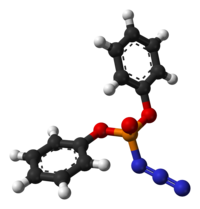Diphenylphosphoryl azide
 |
|
 |
|
 |
|
| Names | |
|---|---|
|
IUPAC name
Diphenyl phosphorazidate
|
|
| Other names
Diphenoxyphosphoryl azide
Diphenylphosphonic azide Diphenyl azidophosphate Phosphoric acid diphenyl ester azide |
|
| Identifiers | |
|
3D model (JSmol)
|
|
| Abbreviations | DPPA |
| ChemSpider | |
| ECHA InfoCard | 100.043.298 |
|
PubChem CID
|
|
|
|
|
|
| Properties | |
| C12H10N3O3P | |
| Molar mass | 275.20 g·mol−1 |
| Appearance | Colourless or faintly yellow liquid |
| Density | 1.277 g/cm3 |
| Boiling point | 157 °C (315 °F; 430 K) (0.2 mmHg) |
| Hazards | |
|
EU classification (DSD) (outdated)
|
Toxic (T) |
| NFPA 704 | |
| Flash point | 112 °C (234 °F; 385 K) |
|
Except where otherwise noted, data are given for materials in their standard state (at 25 °C [77 °F], 100 kPa).
|
|
|
|
|
| Infobox references | |
Diphenylphosphoryl azide (DPPA; alternative, more precise name: diphenoxyphosphoryl azide; IUPAC name: diphenyl phosphorazidate) is an organic compound. It is widely used in synthesis of other organic compounds.
DPPA undergoes pseudohalogen replacement of the azido group by treatment with nucleophilic reagents, such as water, butanol, ammonia, and various amines.
This compound is used as a reagent for the synthesis of peptides by virtue of its reactions with carboxylic acids leading to either the urethane or the amide. The formation of the urethane is particularly valuable since it works with carboxylic acids which fail to undergo the Schmidt reaction, and is believed to involve transfer of the azido group to the carboxylic acid.
It is now suggested that this reaction proceeds through the intermediate mixed anhydride, resulting from attack by the nucleophilic carboxylate anion on the phosphorus atom, with expulsion of the azide ion. The latter then attacks the carbonyl carbon atom, to give the acyl azide and loss of the diphenylphosphate anion, known to be a good leaving group. Finally, the acyl azide reacts in the normal manner to give the urethane.
Studies show that DPPA reacts with amines giving the corresponding phosphoramidates; it therefore appears that formation of the amide similarly involves the intermediate anhydride, followed by nucleophilic substitution by the amine.
...
Wikipedia

